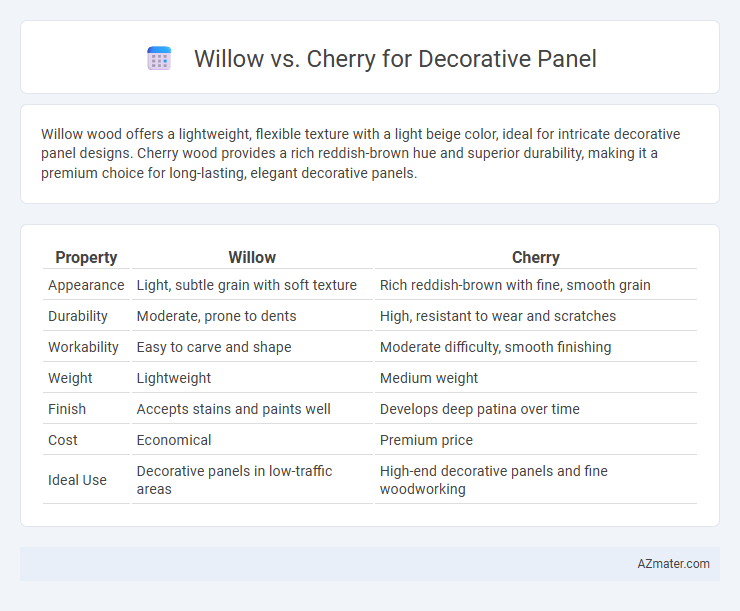Willow wood offers a lightweight, flexible texture with a light beige color, ideal for intricate decorative panel designs. Cherry wood provides a rich reddish-brown hue and superior durability, making it a premium choice for long-lasting, elegant decorative panels.
Table of Comparison
| Property | Willow | Cherry |
|---|---|---|
| Appearance | Light, subtle grain with soft texture | Rich reddish-brown with fine, smooth grain |
| Durability | Moderate, prone to dents | High, resistant to wear and scratches |
| Workability | Easy to carve and shape | Moderate difficulty, smooth finishing |
| Weight | Lightweight | Medium weight |
| Finish | Accepts stains and paints well | Develops deep patina over time |
| Cost | Economical | Premium price |
| Ideal Use | Decorative panels in low-traffic areas | High-end decorative panels and fine woodworking |
Introduction to Decorative Panels
Decorative panels serve as versatile design elements that enhance interior and exterior spaces through texture, color, and pattern. Willow panels offer a natural, warm aesthetic with intricate grain patterns ideal for creating a cozy atmosphere. Cherry panels provide a rich, reddish hue and smooth finish that bring elegance and sophistication to any decorative application.
Overview of Willow and Cherry Wood
Willow wood offers a lightweight, flexible structure with a fine, uniform texture that enhances decorative panels with a smooth finish and natural, warm tones. Cherry wood is prized for its rich, reddish-brown color and tight grain pattern, providing durability and a luxurious appearance that deepens with age. Both woods are favored in paneling for their aesthetic qualities, but willow is typically chosen for its softness and ease of working, while cherry is selected for strength and elegant aging.
Visual Appeal: Grain and Color Comparison
Willow decorative panels feature a subtle, flowing grain with light to medium brown tones that evoke a natural, rustic charm suitable for warm interiors. Cherry panels display a rich, reddish-brown hue that deepens over time, paired with a smooth, fine grain, offering a classic and elegant aesthetic. The contrast between willow's understated texture and cherry's vibrant color makes each ideal for distinct design styles, enhancing visual appeal through grain and color interplay.
Durability and Longevity of Willow vs Cherry
Willow wood offers moderate durability with natural resistance to moisture but is softer and more prone to dents and scratches compared to cherry wood. Cherry wood boasts superior hardness and density, enhancing its resistance to wear, impact, and indoor environmental changes, leading to greater longevity in decorative panels. Over time, cherry wood panels develop a rich patina, maintaining structural integrity and aesthetic appeal longer than willow panels.
Workability and Crafting Differences
Willow offers superior flexibility and ease of carving due to its softer grain, making it ideal for intricate decorative panel designs that require detailed craftsmanship. Cherry wood, with a denser and harder texture, demands more skill and sharper tools but results in smoother finishes and enhanced durability for decorative applications. The contrasting workability between willow and cherry significantly influences the choice of wood based on the desired balance between detailed artistry and long-lasting structural integrity in decorative panels.
Cost Comparison: Willow vs Cherry Panels
Willow panels typically cost less than cherry panels, making them a budget-friendly choice for decorative applications. Cherry wood is prized for its rich color and fine grain, which often commands a higher price due to its premium quality and durability. Choosing between willow and cherry largely depends on balancing budget constraints with desired aesthetic and longevity in decorative panel installations.
Environmental Impact and Sustainability
Willow panels offer superior sustainability due to their rapid growth rate and ability to regenerate quickly without heavy pesticide use, making them an eco-friendly choice for decorative applications. Cherry wood, while valued for its aesthetic appeal, has a slower growth cycle, leading to higher environmental impact from longer harvesting periods and potential habitat disruption. Selecting willow panels supports carbon sequestration and reduces deforestation risks compared to cherry, aligning better with green building practices.
Maintenance and Care Tips
Willow decorative panels require minimal maintenance due to their natural resistance to moisture and pests, making them ideal for both indoor and outdoor use. Cherry panels, while visually striking with rich reddish hues, demand more careful upkeep, including regular polishing and protection from direct sunlight to prevent fading. Both materials benefit from gentle cleaning with a damp cloth and avoidance of harsh chemicals to maintain their finish and longevity.
Popular Design Styles for Each Wood
Willow panels feature a natural, rustic aesthetic that complements farmhouse and Scandinavian design styles, prized for their light tones and intricate grain patterns. Cherry wood panels offer a warm, rich hue with smooth textures, ideal for traditional, colonial, and craftsman interiors that emphasize elegance and timeless appeal. Both woods enhance decorative paneling with unique visual textures suited to distinct design preferences, making them popular choices for bespoke wall treatments.
Choosing the Best Wood for Decorative Panels
Willow offers a lightweight, flexible option with a rustic texture ideal for intricate decorative panels, while cherry wood provides a rich, warm tone and smooth grain that enhances elegance and durability. Cherry's natural aging process deepens its color, making it preferable for timeless, high-end panel designs, whereas willow's affordability and ease of carving suit budget-friendly, artistic applications. Selecting between willow and cherry depends on desired aesthetics, panel longevity, and project budget, with cherry favored for premium finishes and willow for creative versatility.

Infographic: Willow vs Cherry for Decorative Panel
 azmater.com
azmater.com